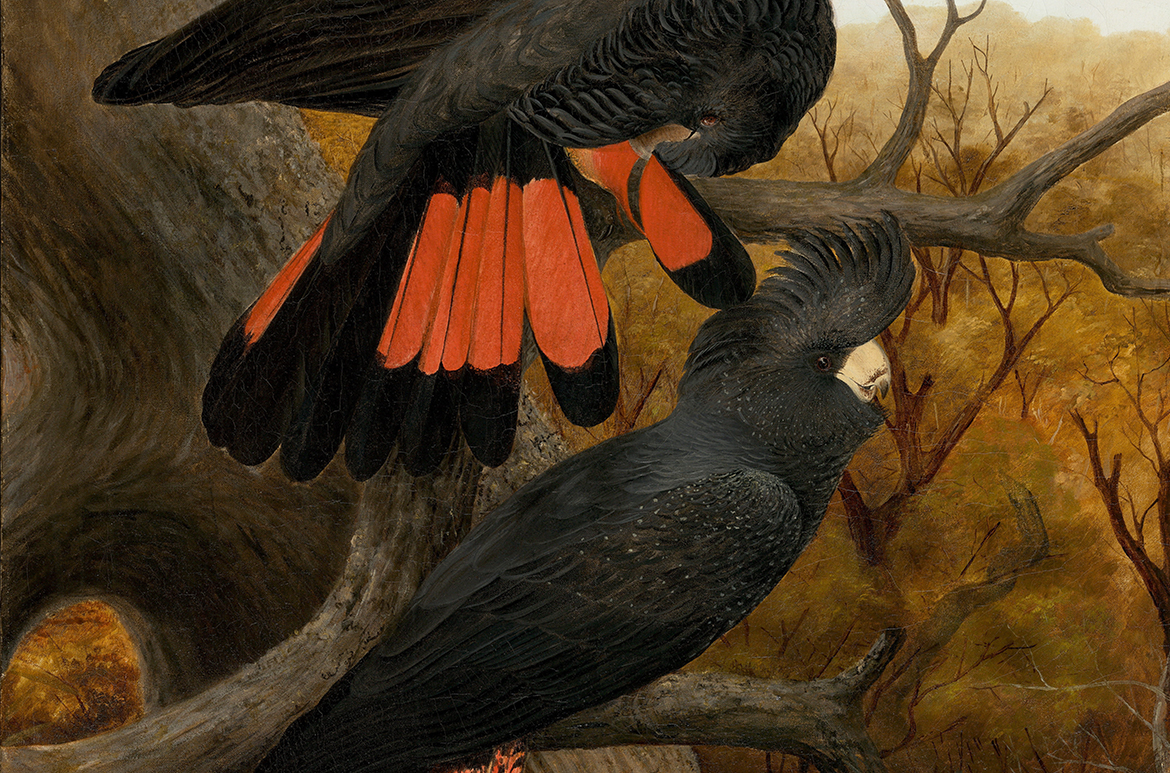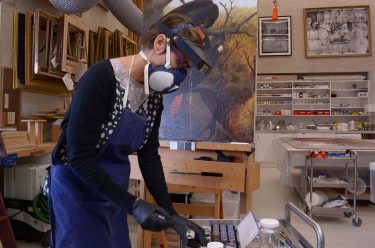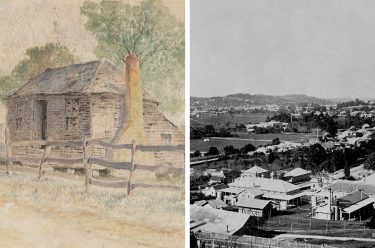We delve into a major reframing project for prominent Queensland ornithological artist and taxidermist Anthony Alder’s (1838-1915) painting Red-tailed Black Cockatoos c.1895 currently on display in the Queensland Art Gallery’s Australian Art collection.
Anthony Alder (Standing 3rd from the right)

DELVE DEEPER: Go behind-the-scenes as we conserve ‘Red-tailed Black Cockatoos’
The oil on canvas Red-tailed Black Cockatoos (illustrated) acquired in 2014 entered the QAGOMA Collection retaining only its original slip and without a picture frame. It is uncommon for a painting to enter the Gallery’s Collection unframed, yet this is the case with this Adler work, therefore, while the painting was undergoing conservation treatment, the Conservation Frames and Furniture Section commenced researching reframing options of frame styles that were historically accurate and aesthetically suitable for paintings by Alder.
Before conservation: ‘Red-tailed Black Cockatoos’ 1895
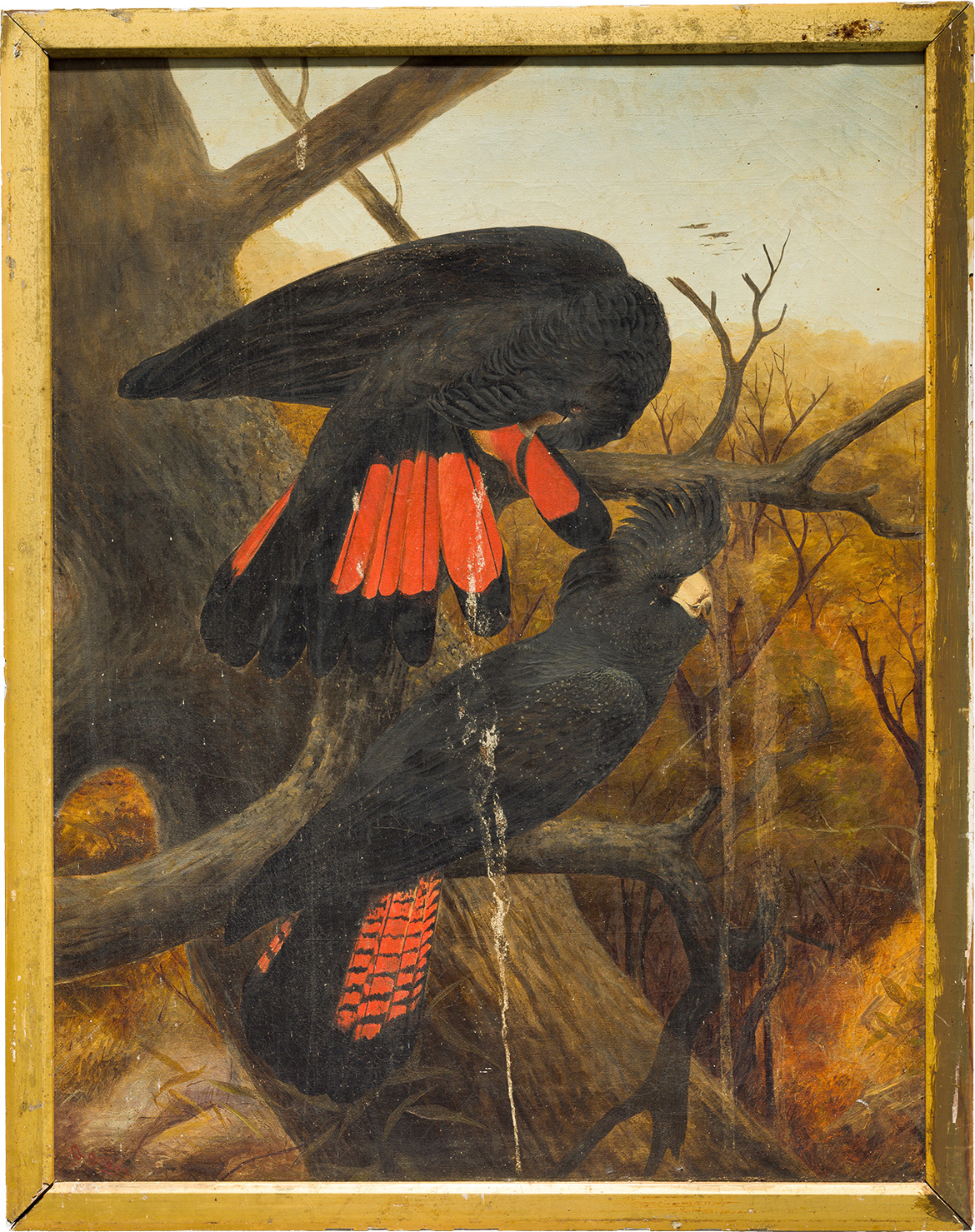
Reframing paintings at QAGOMA is based on in-depth research, historical accuracy, and a knowledge of art and art history. There are numerous resources available when researching historic picture frames, and in the case of Red-tailed Black Cockatoos, our research commenced with Heron’s home 1895 (illustrated), another painting by Alder in our Collection.
Heron’s home was acquired in 2011 in an original 19th century picture frame that incorporates traditional frame making techniques and materials. Picture frames such as this were made or supplied by either an established picture frame making firm or importers of gilt mouldings.
TIME-LAPSE: Watch as the original colours are restored in Anthony Alders ‘Heron’s home’
To prepare Heron’s home for display, both the painting and frame required conservation treatment. While working on the frame, it was revealed that all the original compo ornament from the top edge and sight edge of the picture frame had been removed, prior to the gold overpaint being applied.
Frame during conservation: ‘Heron’s home’
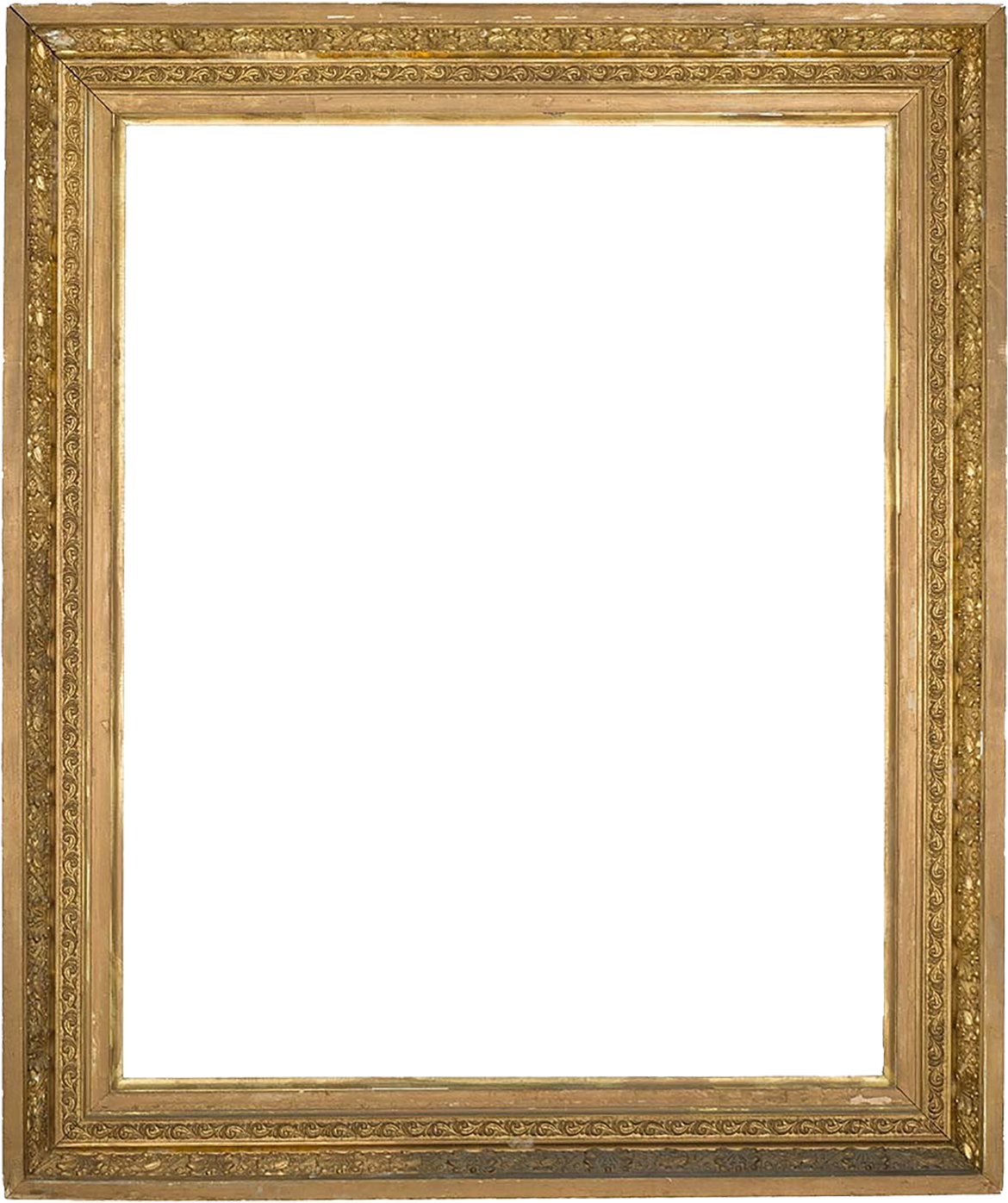

Painting after conservation: ‘Heron’s home’ 1895
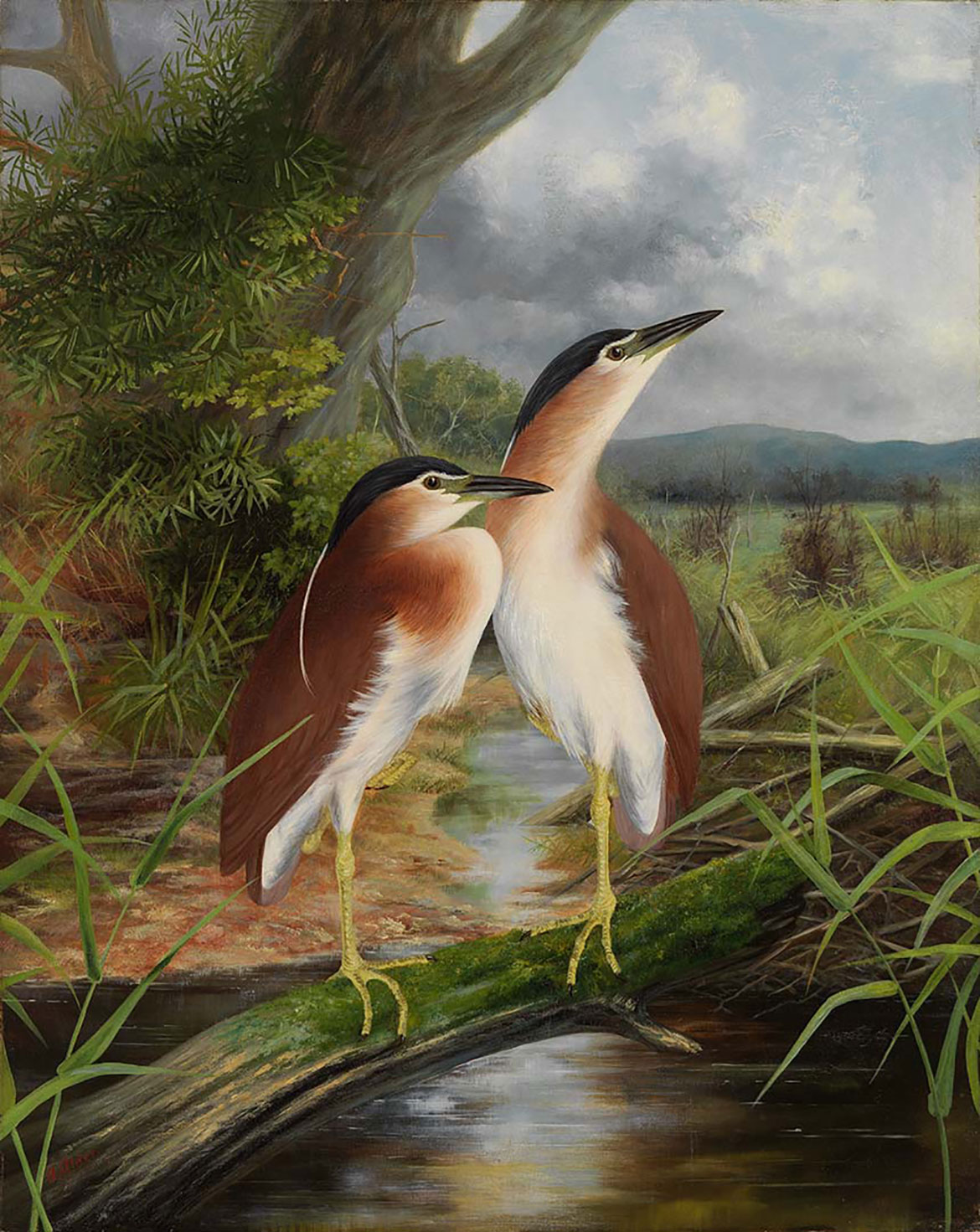
The most exciting stage of the treatment revealed the inscription ‘Mr Alder’, written in pencil on the verso of Heron’s home frame, providing a tangible link between artist, painting and frame. Unfortunately, no other frame maker’s labels or inscriptions relating to who the frame maker was, or when or where the frame was made were found.
‘Mr Alder’ inscribed on the verso of ‘Heron’s home’ picture frame
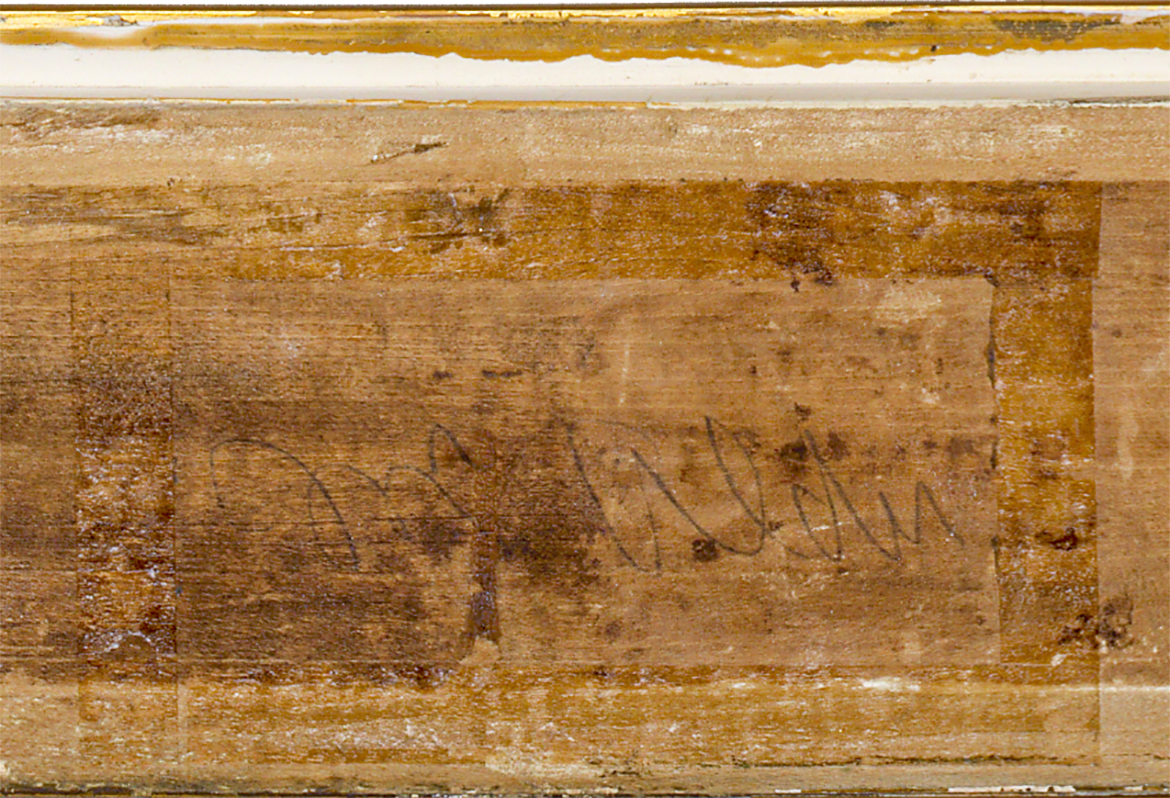
Publications on Anthony Alder reveal some relevant information:
‘most of the works held by the [Alder] family are still in their original highly ornate gilt frames which, according to the family, were made by Alder himself’.
‘He also produced a wide range of castings including fruit, fish and gold specimens, all in exceptional detail and painted in naturalistic colours. At the Greater Britain Exhibition in 1899 he received a gold medal diploma for gilded replicas of large cakes of retorted gold from mines at Gympie and Charters Towers’
‘Alder was also a skilled cabinet maker’.1
There is a long history of artists designing, and in some instances making their own picture frames. Given Alder’s expertise in cabinet making, casting, and gilding, and the accounts of his descendants, this raised the question… is it possible that Alder made his own picture frames?
Our research continued with visits to precinct partners, State Library of Queensland and Queensland Museum who also have paintings by Alder in their collections. Two works of particular interest are Lincoln sheep, Homeward Laddie 1895 (illustrated), and Eagle and Fox (Not Game) 1895 (illustrated). Being of similar scale and profile, these picture frames are virtually identical to the frame on Heron’s home, employing the same gilding scheme, consisting of the undecorated areas being water gilt and the compo ornament being oil gilt. The main variation is the use of different styles of ornament employed to decorate each picture frame. This information proved crucial in understanding Alder’s choices of picture frames in 1895.
Profile of the picture frame: ‘Heron’s home’
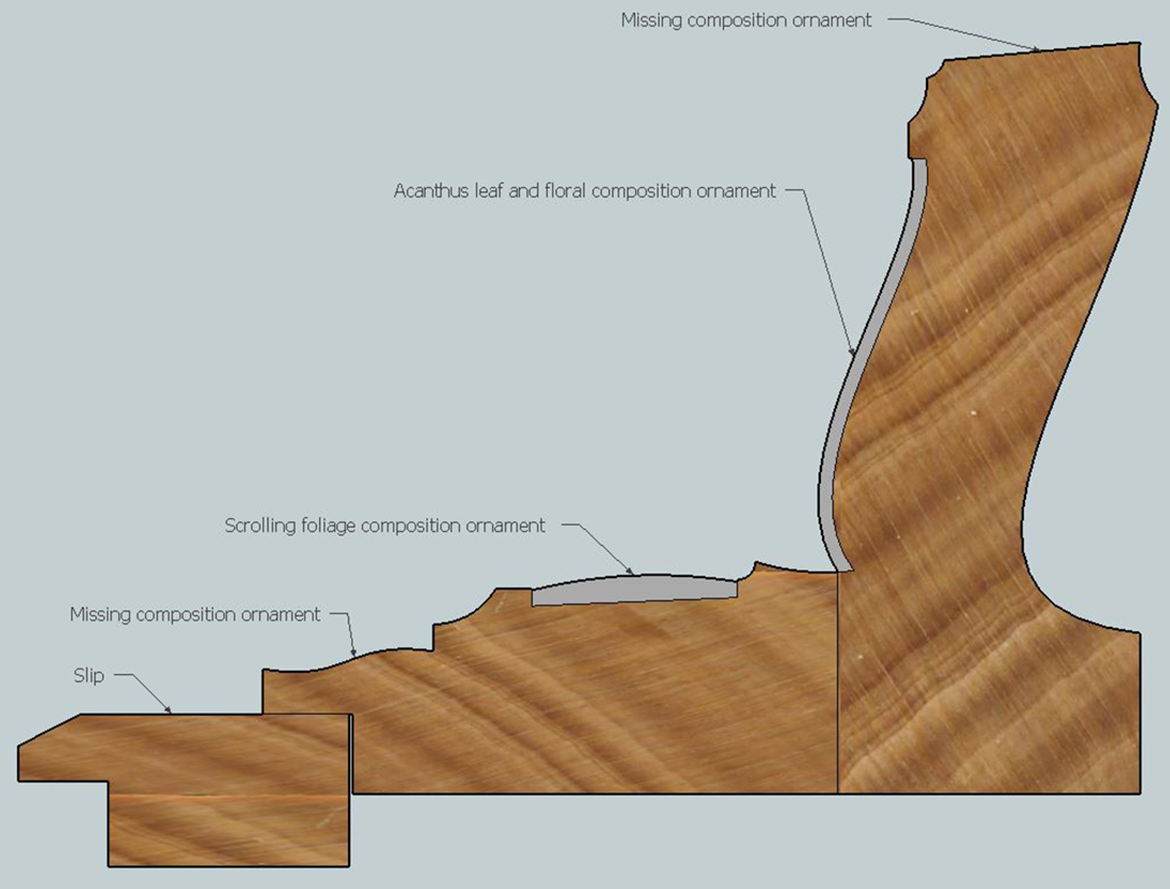
Picture frame: ‘Lincoln sheep, Homeward Laddie’
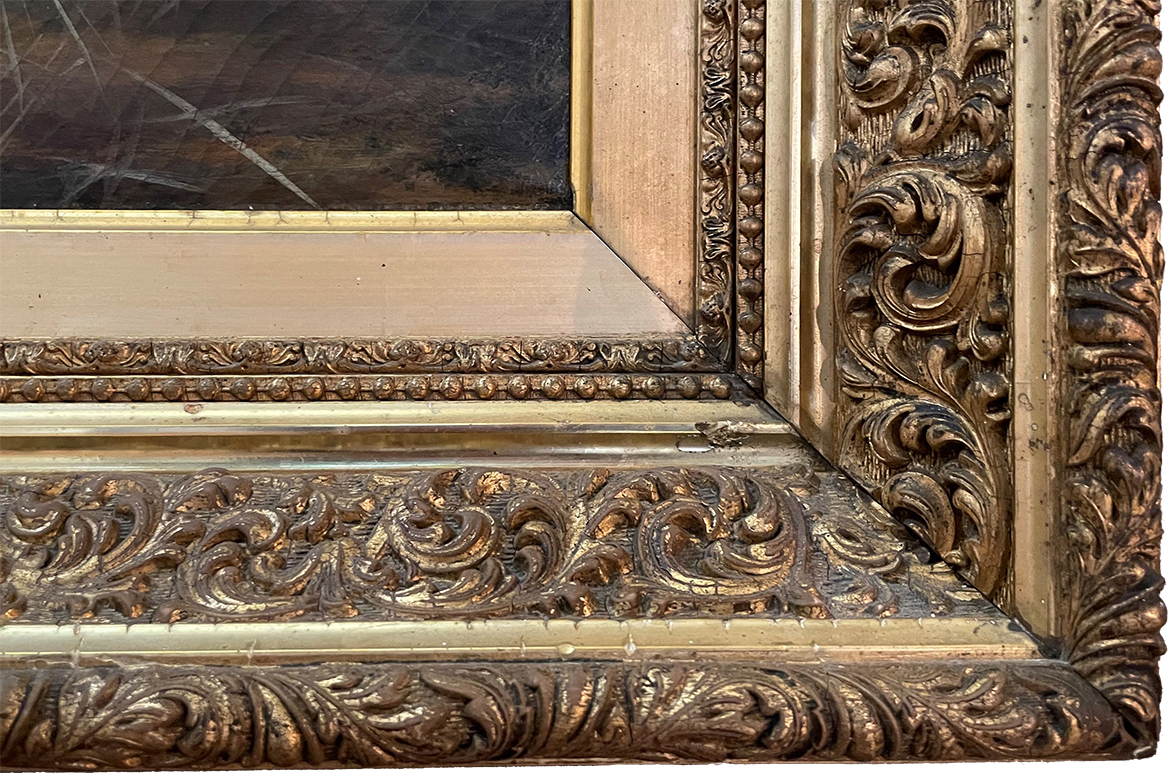
Anthony Alder ‘Lincoln sheep, Homeward Laddie’ 1895

Picture frame: ‘Eagle and Fox (Not Game)’
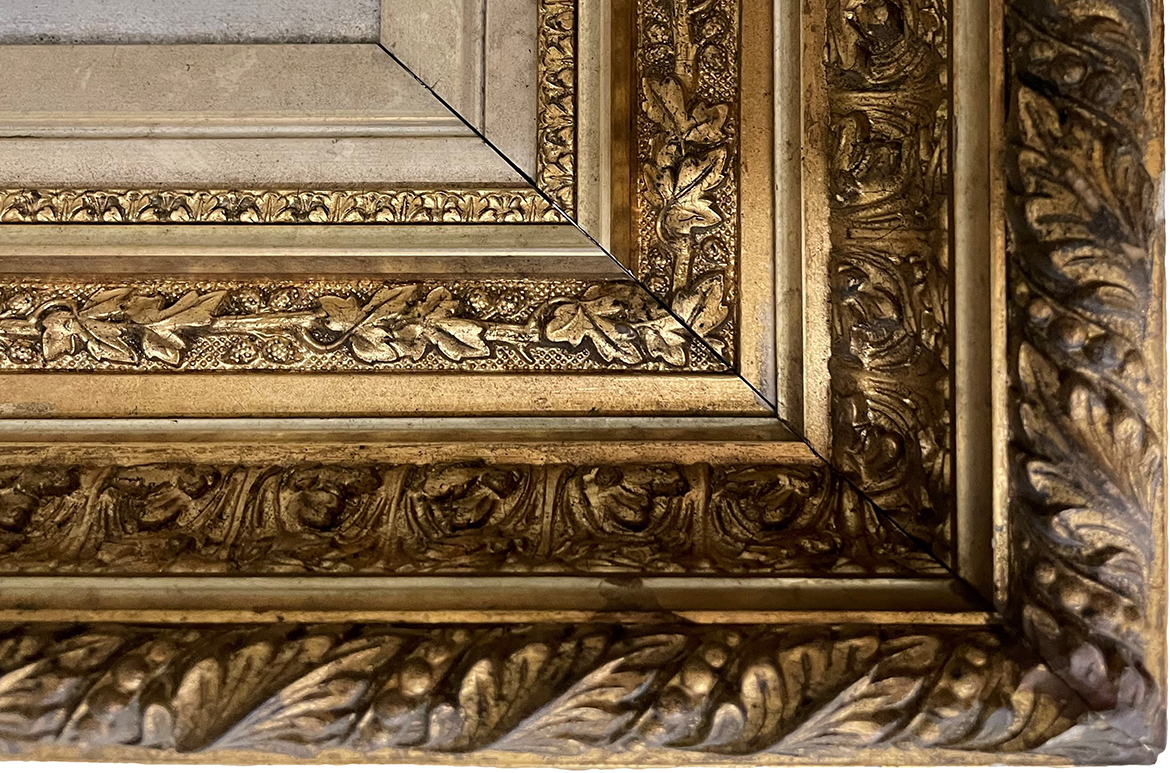
Anthony Alder ‘Eagle and Fox (Not Game)’ 1895

However the question remained… are all these picture frames made by Alder himself? If by ‘made’ we are referring to purchasing prefinished mouldings, cutting, gluing and joining the mitres, then possibly yes. However, if one is referring to producing the profiled moulding, applying the compo ornament, and executing the various gilding finishes then this is highly unlikely. To manufacture picture frames of this quality, specialised woodworking machinery is required, stocks of different compo moulds are needed, and the knowledge of specialised picture framing gilding techniques is paramount.
Although the construction methods, materials, and gilding techniques employed on the three frames for Heron’s home; Lincoln sheep, Homeward Laddie; and Eagle and Fox (Not Game) — all painted in 1895 — are typically 19th century, the deep moulding profile, and the four separate sections of compo ornament are unique. This lead to the belief that the picture frames undoubtedly have the same provenance.
Although distinctive in style, I found the style of frames to be somewhat familiar. I distinctly remember encountering a similar frame on another painting within the Gallery’s Collection. During a stroll through Collection Storage, my search was rewarded as I came across the frame I was looking for on Oscar Friström’s portrait, Duramboi, from 1893, (illustrated) also on display at the Queensland Art Gallery’s Australian Art collection.
A contemporary of Alder, Friström was a prominent Brisbane portrait painter. Duramboi is framed in yet another version of the picture frames found on the three Alder paintings, it has the same deep moulding profile, four different sections of compo ornament and the same gilding scheme.
Oscar Friström ‘Duramboi’ 1893

Two crucial pieces of information are uncovered during the examination of the Duramboi frame. Firstly, Friström donated the artwork to the Gallery in 1895, two years after it was painted, which dates the picture frame between 1893 and 1895. Secondly, I find the most important piece of information when I turn the picture frame over — to my delight the remnants of a picture frame maker’s label are attached to the verso of the frame. Despite being in poor condition, the address of ‘Kent’s Buildings’ is legible.
Picture frame makers label on verso of ‘Duramboi’
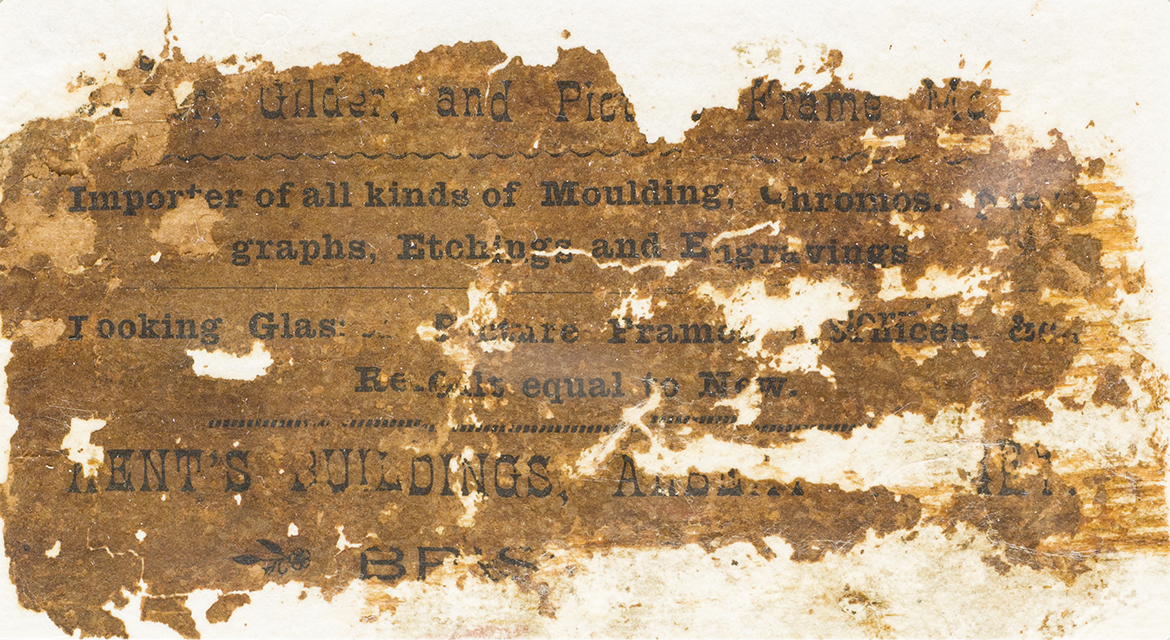
I’m familiar with the address of Kent’s Buildings, and I’m aware that the individual who operated from that premises was William Lewis Hambleton, who traded under the name A L Hambleton. This is confirmed through my ongoing research project, where I am compiling a database of Brisbane and Queensland picture frame makers of the19th and early 20th century.
A L Hambleton first opened for business in 1889 at 24 Queen Street, Brisbane, and in 1890 moved to Kent’s Building’s, on the corner of Albert and Adelaide Streets, remaining there until 1924, when the building was demolished. During this time A L Hambleton was one of Brisbane’s most established carver, gilder, picture frame maker, and importer of mouldings.
This information holds significant importance in determining the origin and creator of the picture frames. The undisputed evidence attributing A L Hambleton as the manufacturer of the Duramboi picture frame suggests that A L Hambleton was either responsible for making the three original Alder frames listed above or supplied the embellished and gilded mouldings to ‘Mr. Alder’.
Kent Buildings, corner Adelaide and Albert Streets
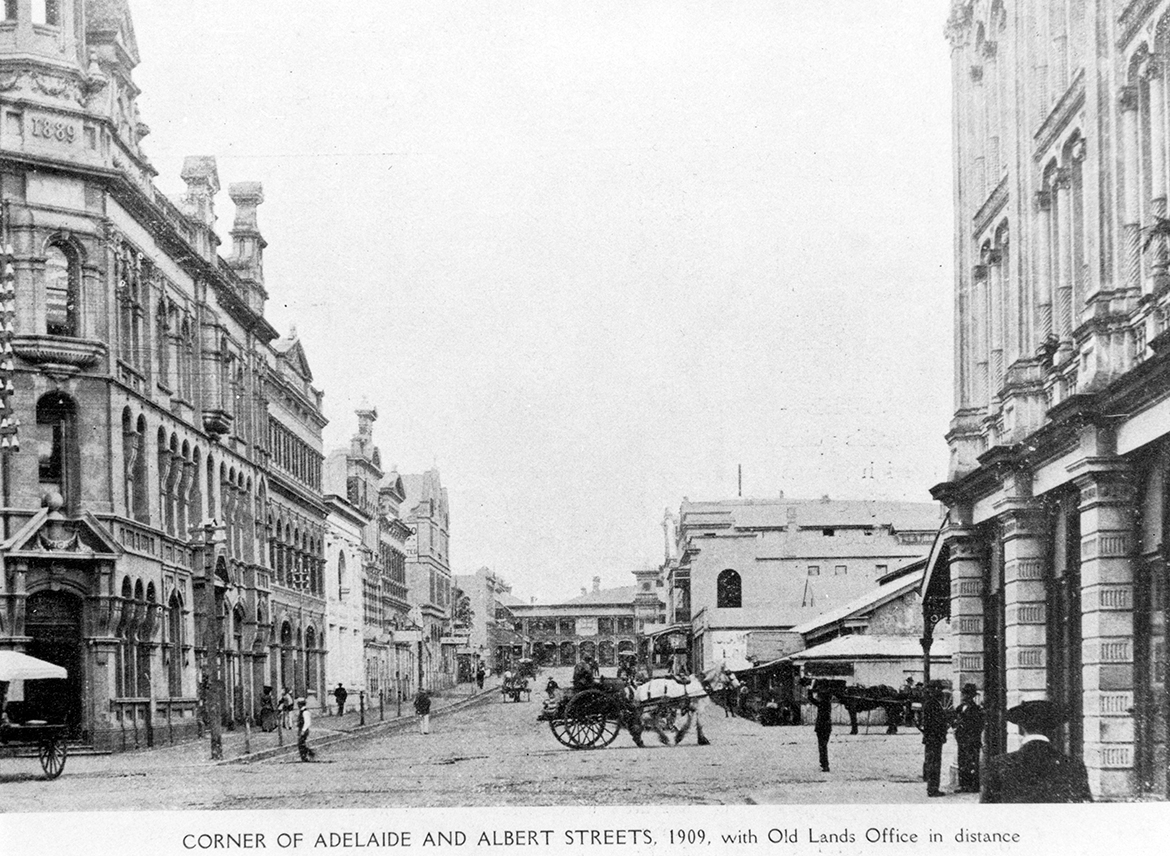

The research clearly demonstrates this was Alder’s preferred style of frame which he selected to use on his three paintings completed in 1895. This evidence was then presented to the stakeholders involved in the project, with a proposal to replicate Heron’s home frame, after careful deliberation it was agreed to proceed with the proposal and create a replica for Red-tailed Black Cockatoos. The replica frame, made in the Gallery’s Frames Studio using traditional 19th century materials and techniques, and the conserved painting are now on display.
Leading the Conservation Framing and Furniture Section it is my utmost pleasure and privilege to contribute and continue to preserve the traditions, the history, and legacy of Brisbane Picture Frame Makers through my role in researching, making, and conserving historical frames.
Robert Zilli is Conservation Framer, QAGOMA
Endnote
1 Dianne F Byrne, Kevin J Lambkin, ‘Anthony Alder (1838–1915), Queensland taxidermist and bird painter’, Archives of Natural History, April 2010, vo. 37, No. 1: pp. 58-73
After conservation with new frame: ‘(Red-tailed Black Cockatoos)’ 1895

#QAGOMA
